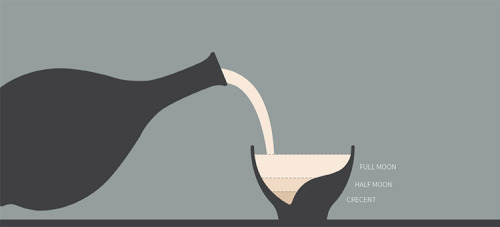Mars Used To Be Much More Earth-like Than We Once Thought. The Curiosity Rover Recently Discovered High

Mars used to be much more Earth-like than we once thought. The Curiosity rover recently discovered high levels of manganese oxide, which can only exist in oxygen-rich environments. This means Mars used to have as much oxygen as Earth and plenty of water on its surface. Source Source 2
More Posts from Maevetheeuropan and Others

Yeeeeeeeeees!
I am filled with such excitement!
HUGE ANNOUNCEMENT!
Elon Musk is set to announce his plans for Mars colonization in an hour, at 2:30 Eastern Time.
Please watch it because this could be history in the making.






Moon Glass: A Ceramic Cup That Showcases the Different Phases of the Moon the More You Drink From It
South Korean design studio Tale Co., Ltd. has created an ingenious ceramic liquor called the Moon Glass, which displays different phases of the moon as you drink from it. The adorable glasses are available to purchase on their website.
Solar System: Things to Know This Week
Learn about the science of photonics to create space communications, get updates on Juno, mining data from Voyager for new discoveries and more.

1. Carried on a Beam of Light
One of our major priorities is to make space communications more efficient. While our communications systems have matured over the decades, they still use the same radio-frequency system developed in the earliest days of the agency. After more than 50 years, we’re investing in new ways to increase data rates while also finding more efficient communications systems. Photonics–generating, detecting and manipulating particles of light–may provide the solution.
+ See how it works

2. It’s No Joke: Two New Moons for the Seventh Planet
Voyager 2 spacecraft flew by Uranus 30 years ago, but researchers are still making discoveries using the data it gathered. A new study led by University of Idaho researchers suggests there could be two tiny, previously undiscovered moonlets orbiting near two of the planet’s rings.
+ Find out how they were discovered

3. Vortex of Mystery
As southern winter solstice approaches in the Saturn system, our Cassini spacecraft has revealed dramatic seasonal changes in the atmospheric temperature and composition of Saturn’s largest moon, Titan. Winter is taking a grip on Titan’s southern hemisphere, and a strong, whirling vortex has intensified in the upper atmosphere over the south pole.
+See more

4. The Spiders of Mars
Ten thousand volunteers viewing images of Martian south polar regions have helped identify targets for closer inspection, yielding new insights about seasonal slabs of frozen carbon dioxide and erosional features known as “spiders.” From the comfort of home, the volunteers have been exploring the surface of Mars by reviewing images from the Context Camera on our Mars Reconnaissance Orbiter and identifying certain types of seasonal terrains near Mars’ south pole.
+ Learn more and see how you can join in

7. Better Safe than Sorry
Juno entered safe mode last week and early indications are a software performance monitor induced a reboot of the spacecraft’s onboard computer. In this case, the safe mode turned off instruments and a few non-critical spacecraft components, and it confirmed the spacecraft was pointed toward the sun to ensure the solar arrays received power.The spacecraft acted as expected during the transition into safe mode, restarted successfully and is healthy. High-rate data has been restored, and the spacecraft is conducting flight software diagnostics. Meanwhile, the Juno science team continues to analyze returns from the first close Jupiter flyby on Aug. 27. Revelations so far include that Jupiter’s magnetic fields and aurora are bigger and more powerful than thought. Scientists have also had their first glimpse below the planet’s swirling cloud deck. The next close flyby is scheduled on Dec. 11, with all science instruments on.
+ Get the details
Discover the full list of 10 things to know about our solar system this week HERE.
Make sure to follow us on Tumblr for your regular dose of space: http://nasa.tumblr.com
omfg I wanna buy this as a poster


Do not go gentle into that good night. Rage, rage against the dying of the light.
Getting to Mars: 4 Things We’re Doing Now
We’re working hard to send humans to Mars in the 2030s. Here are just a few of the things we’re doing now that are helping us prepare for the journey:
1. Research on the International Space Station

The International Space Station is the only microgravity platform for the long-term testing of new life support and crew health systems, advanced habitat modules and other technologies needed to decrease reliance on Earth.

When future explorers travel to the Red Planet, they will need to be able to grow plants for food, atmosphere recycling and physiological benefits. The Veggie experiment on space station is validating this technology right now! Astronauts have grown lettuce and Zinnia flowers in space so far.

The space station is also a perfect place to study the impacts of microgravity on the human body. One of the biggest hurdles of getting to Mars in ensuring that humans are “go” for a long-duration mission. Making sure that crew members will maintain their health and full capabilities for the duration of a Mars mission and after their return to Earth is extremely important.

Scientists have solid data about how bodies respond to living in microgravity for six months, but significant data beyond that timeframe had not been collected…until now! Former astronaut Scott Kelly recently completed his Year in Space mission, where he spent a year aboard the space station to learn the impacts of microgravity on the human body.
A mission to Mars will likely last about three years, about half the time coming and going to Mars and about half the time on the Red Planet. We need to understand how human systems like vision and bone health are affected and what countermeasures can be taken to reduce or mitigate risks to crew members.
2. Utilizing Rovers & Tech to Gather Data

Through our robotic missions, we have already been on and around Mars for 40 years! Before we send humans to the Red Planet, it’s important that we have a thorough understanding of the Martian environment. Our landers and rovers are paving the way for human exploration. For example, the Mars Reconnaissance Orbiter has helped us map the surface of Mars, which will be critical in selecting a future human landing site on the planet.

Our Mars 2020 rover will look for signs of past life, collect samples for possible future return to Earth and demonstrate technology for future human exploration of the Red Planet. These include testing a method for producing oxygen from the Martian atmosphere, identifying other resources (such as subsurface water), improving landing techniques and characterizing weather, dust and other potential environmental conditions that could affect future astronauts living and working on Mars.

We’re also developing a first-ever robotic mission to visit a large near-Earth asteroid, collect a multi-ton boulder from its surface and redirect it into a stable orbit around the moon. Once it’s there, astronauts will explore it and return with samples in the 2020s. This Asteroid Redirect Mission (ARM) is part of our plan to advance new technologies and spaceflight experience needed for a human mission to the Martian system in the 2030s.
3. Building the Ride
Okay, so we’ve talked about how we’re preparing for a journey to Mars…but what about the ride? Our Space Launch System, or SLS, is an advanced launch vehicle that will help us explore beyond Earth’s orbit into deep space. SLS will be the world’s most powerful rocket and will launch astronauts in our Orion spacecraft on missions to an asteroid and eventually to Mars.

In the rocket’s initial configuration it will be able to take 154,000 pounds of payload to space, which is equivalent to 12 fully grown elephants! It will be taller than the Statue of Liberty and it’s liftoff weight will be comparable to 8 fully-loaded 747 jets. At liftoff, it will have 8.8 million pounds of thrust, which is more than 31 times the total thrust of a 747 jet. One more fun fact for you…it will produce horsepower equivalent to 160,000 Corvette engines!

Sitting atop the SLS rocket will be our Orion spacecraft. Orion will be the safest most advanced spacecraft ever built, and will be flexible and capable enough to carry humans to a variety of destinations. Orion will serve as the exploration vehicle that will carry the crew to space, provide emergency abort capability, sustain the crew during space travel and provide safe re-entry from deep space return velocities.
4. Making it Sustainable
When humans get to Mars, where will they live? Where will they work? These are questions we’ve already thought about and are working toward solving. Six partners were recently selected to develop ground prototypes and/or conduct concept studies for deep space habitats.

These NextSTEP habitats will focus on creating prototypes of deep space habitats where humans can live and work independently for months or years at a time, without cargo supply deliveries from Earth.

Another way that we are studying habitats for space is on the space station. In June, the first human-rated expandable module deployed in space was used. The Bigelow Expandable Activity Module (BEAM) is a technology demonstration to investigate the potential challenges and benefits of expandable habitats for deep space exploration and commercial low-Earth orbit applications.
Our journey to Mars requires preparation and research in many areas. The powerful new Space Launch System rocket and the Orion spacecraft will travel into deep space, building on our decades of robotic Mars explorations, lessons learned on the International Space Station and groundbreaking new technologies.
Make sure to follow us on Tumblr for your regular dose of space: http://nasa.tumblr.com

For American science, the next four years look to be challenging. The newly inaugurated President Trump, and many of his Cabinet picks, have repeatedly cast doubt upon the reality of human-made climate change, questioned the repeatedly proven safety of vaccines. Since the inauguration, the administration has already frozen grants and contracts by the Environmental Protection Agency and gagged researchers at the US Department of Agriculture. Many scientists are asking themselves: What can I do?
And the answer from a newly formed group called 314 Action is: Get elected.

The organization, named after the first three digits of pi, is a political action committee that was created to support scientists in running for office. It’s the science version of Emily’s List, which focuses on pro-choice female candidates, or VoteVets, which backs war veterans. “A lot of scientists traditionally feel that science is above politics but we’re seeing that politics is not above getting involved in science,” says founder Shaughnessy Naughton.
“We’re losing, and the only way to stop that is to get more people with scientific backgrounds at the table.”
(Continue Reading)
omg okay so this is pretty interesting but I HAVE SO MANY QUESTIONS . . . I need to think more about this but I have my . . . doubts XD
@maevemauvaise I can’t vouch for the veracity but this is pretty damn cool.
-
 colorfulcollectorpirate liked this · 2 years ago
colorfulcollectorpirate liked this · 2 years ago -
 randommouseclick liked this · 5 years ago
randommouseclick liked this · 5 years ago -
 casuallycrookedartisan-blog1 liked this · 5 years ago
casuallycrookedartisan-blog1 liked this · 5 years ago -
 werewolfin liked this · 5 years ago
werewolfin liked this · 5 years ago -
 tellasalt liked this · 6 years ago
tellasalt liked this · 6 years ago -
 sherif713 liked this · 6 years ago
sherif713 liked this · 6 years ago -
 sunshowermess liked this · 7 years ago
sunshowermess liked this · 7 years ago -
 packshett reblogged this · 7 years ago
packshett reblogged this · 7 years ago -
 kellypinky-blog liked this · 8 years ago
kellypinky-blog liked this · 8 years ago -
 divine-femenine reblogged this · 8 years ago
divine-femenine reblogged this · 8 years ago -
 divine-femenine liked this · 8 years ago
divine-femenine liked this · 8 years ago -
 kg08-blog1 liked this · 8 years ago
kg08-blog1 liked this · 8 years ago -
 hella-strange reblogged this · 8 years ago
hella-strange reblogged this · 8 years ago -
 hella-strange liked this · 8 years ago
hella-strange liked this · 8 years ago -
 catzuko-blog reblogged this · 8 years ago
catzuko-blog reblogged this · 8 years ago -
 jeremiahballslife liked this · 8 years ago
jeremiahballslife liked this · 8 years ago -
 orbit-planet-seven liked this · 8 years ago
orbit-planet-seven liked this · 8 years ago -
 thebriarbell liked this · 8 years ago
thebriarbell liked this · 8 years ago -
 toearlytofunction-blog liked this · 8 years ago
toearlytofunction-blog liked this · 8 years ago -
 fariquoesentient reblogged this · 8 years ago
fariquoesentient reblogged this · 8 years ago -
 miscellame liked this · 8 years ago
miscellame liked this · 8 years ago -
 windchimedwriter reblogged this · 8 years ago
windchimedwriter reblogged this · 8 years ago -
 inopinion reblogged this · 8 years ago
inopinion reblogged this · 8 years ago -
 mineralfinder liked this · 8 years ago
mineralfinder liked this · 8 years ago -
 bestmediocregamer-blog liked this · 8 years ago
bestmediocregamer-blog liked this · 8 years ago -
 calypsan liked this · 8 years ago
calypsan liked this · 8 years ago -
 silverknightprject reblogged this · 8 years ago
silverknightprject reblogged this · 8 years ago -
 maevetheeuropan reblogged this · 8 years ago
maevetheeuropan reblogged this · 8 years ago -
 roisu-th3-blog liked this · 8 years ago
roisu-th3-blog liked this · 8 years ago -
 tiniestfrog liked this · 8 years ago
tiniestfrog liked this · 8 years ago -
 beetlejuice1463 liked this · 8 years ago
beetlejuice1463 liked this · 8 years ago -
 sauvreng liked this · 8 years ago
sauvreng liked this · 8 years ago -
 naanda1234 liked this · 8 years ago
naanda1234 liked this · 8 years ago -
 8grandiosedelusions reblogged this · 8 years ago
8grandiosedelusions reblogged this · 8 years ago -
 rustedbrandy-blog reblogged this · 8 years ago
rustedbrandy-blog reblogged this · 8 years ago





